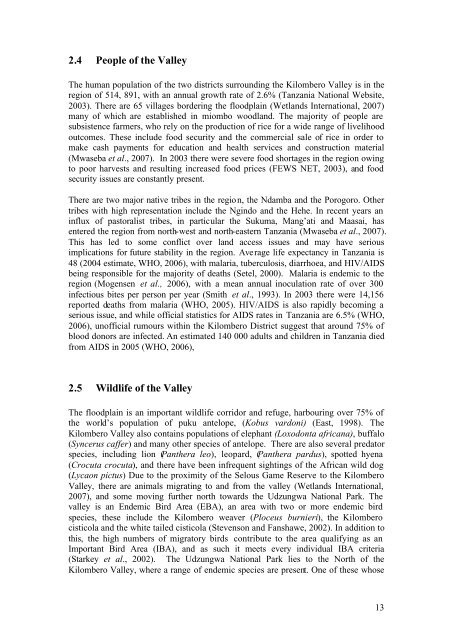Frontier Tanzania Environmental Research - Frontier-publications ...
Frontier Tanzania Environmental Research - Frontier-publications ...
Frontier Tanzania Environmental Research - Frontier-publications ...
You also want an ePaper? Increase the reach of your titles
YUMPU automatically turns print PDFs into web optimized ePapers that Google loves.
2.4 People of the ValleyThe human population of the two districts surrounding the Kilombero Valley is in theregion of 514, 891, with an annual growth rate of 2.6% (<strong>Tanzania</strong> National Website,2003). There are 65 villages bordering the floodplain (Wetlands International, 2007)many of which are established in miombo woodland. The majority of people aresubsistence farmers, who rely on the production of rice for a wide range of livelihoodoutcomes. These include food security and the commercial sale of rice in order tomake cash payments for education and health services and construction material(Mwaseba et al., 2007). In 2003 there were severe food shortages in the region owingto poor harvests and resulting increased food prices (FEWS NET, 2003), and foodsecurity issues are constantly present.There are two major native tribes in the region, the Ndamba and the Porogoro. Othertribes with high representation include the Ngindo and the Hehe. In recent years aninflux of pastoralist tribes, in particular the Sukuma, Mang’ati and Maasai, hasentered the region from north-west and north-eastern <strong>Tanzania</strong> (Mwaseba et al., 2007).This has led to some conflict over land access issues and may have seriousimplications for future stability in the region. Average life expectancy in <strong>Tanzania</strong> is48 (2004 estimate, WHO, 2006), with malaria, tuberculosis, diarrhoea, and HIV/AIDSbeing responsible for the majority of deaths (Setel, 2000). Malaria is endemic to theregion (Mogensen et al., 2006), with a mean annual inoculation rate of over 300infectious bites per person per year (Smith et al., 1993). In 2003 there were 14,156reported deaths from malaria (WHO, 2005). HIV/AIDS is also rapidly becoming aserious issue, and while official statistics for AIDS rates in <strong>Tanzania</strong> are 6.5% (WHO,2006), unofficial rumours within the Kilombero District suggest that around 75% ofblood donors are infected. An estimated 140 000 adults and children in <strong>Tanzania</strong> diedfrom AIDS in 2005 (WHO, 2006),2.5 Wildlife of the ValleyThe floodplain is an important wildlife corridor and refuge, harbouring over 75% ofthe world’s population of puku antelope, (Kobus vardoni) (East, 1998). TheKilombero Valley also contains populations of elephant (Loxodonta africana), buffalo(Syncerus caffer) and many other species of antelope. There are also several predatorspecies, including lion (Panthera leo), leopard, (Panthera pardus), spotted hyena(Crocuta crocuta), and there have been infrequent sightings of the African wild dog(Lycaon pictus) Due to the proximity of the Selous Game Reserve to the KilomberoValley, there are animals migrating to and from the valley (Wetlands International,2007), and some moving further north towards the Udzungwa National Park. Thevalley is an Endemic Bird Area (EBA), an area with two or more endemic birdspecies, these include the Kilombero weaver (Ploceus burnieri), the Kilomberocisticola and the white tailed cisticola (Stevenson and Fanshawe, 2002). In addition tothis, the high numbers of migratory birds contribute to the area qualifying as anImportant Bird Area (IBA), and as such it meets every individual IBA criteria(Starkey et al., 2002). The Udzungwa National Park lies to the North of theKilombero Valley, where a range of endemic species are present. One of these whose13
















